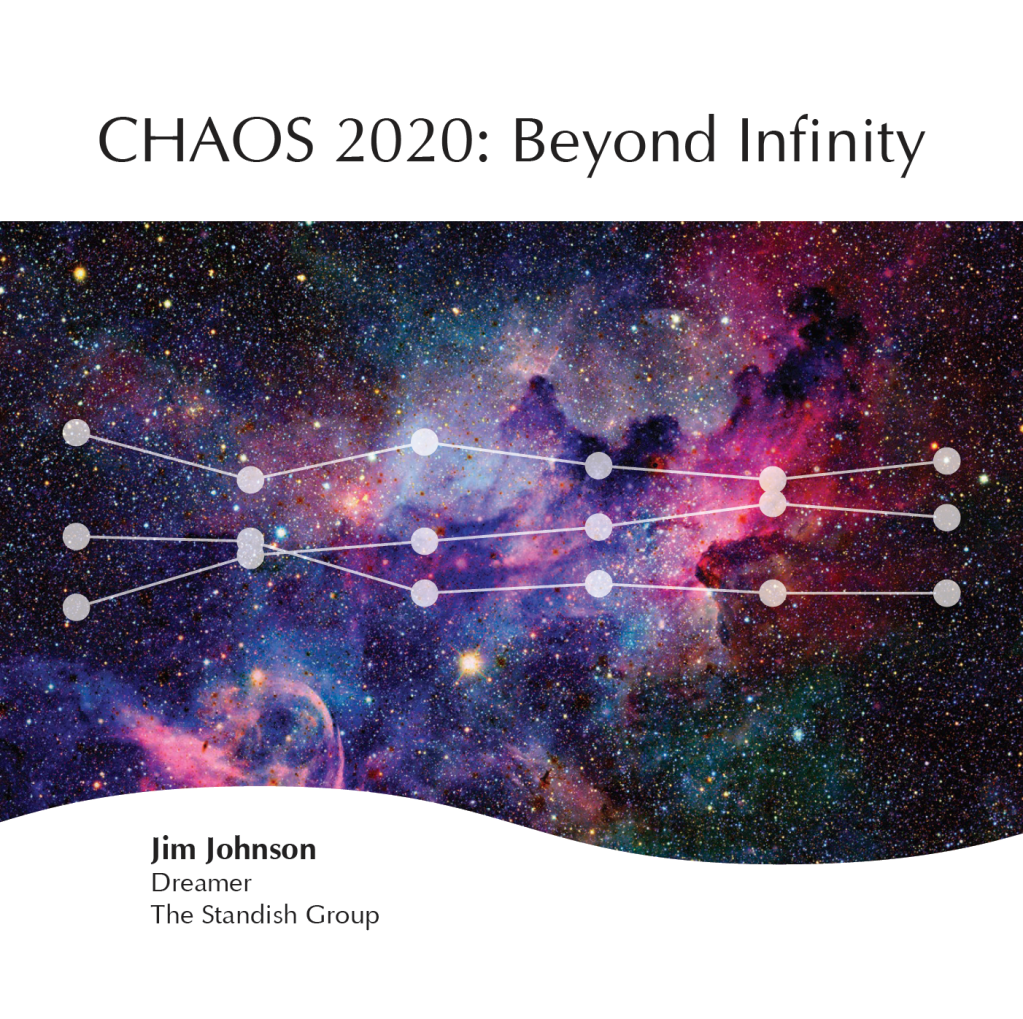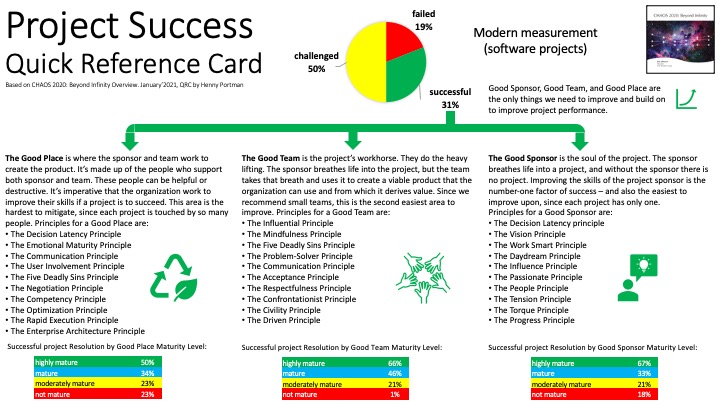
A few weeks ago, I received the latest report from the Standish Group – CHAOS 2020: Beyond Infinity – written by Jim Johnson. Every two years the Standish Group publish a new CHAOS Report.
These reports include classic CHAOS data in different forms with many charts. Most of the charts come from the CHAOS database of over 50,000 in-depth project profiles of the previous 5 years. You have probably seen some of those yellow-red-green charts showing e.g., challenged, failed and successful project percentages.
The book contains ten sections and an epilogue:
- Section I: Factors of Success describes the three factors (good sponsor, good team and good place) the Standish Group has determined most seriously affect the outcome of a software project. Specific attention has been given how poor decision latency and emotional maturity level affect outcomes and the success ladder benchmark.
- Section II: Classic CHAOS provides the familiar charts and information generally found in CHAOS reports. E.g., resolution by traditional measurement, modern measurements, pure measurements and “Bull’s Eye” measurements.
- Section III: Type and styles of projects breaks down project resolution by measurement types and styles of delivery method.

In the next three sections we get an overview of the principles for the good sponsor, the good team and the good place. Each principle is explained in detail, including the required skills to improve the principle and a related chart showing the resolution of all software projects due to poorly skilled, moderately skilled, skilled and very skilled.
- Section IV: The Good Sponsor discusses the skills needed to be a good sponsor. The good sponsor is the soul of the project. The sponsor breathes life into a project, and without the sponsor there is no project. Improving the skills of the project sponsor is the number-one factor of success – and also the easiest to improve upon, since each project has only one. Principles for a good sponsor are:
- The Decision Latency principle
- The Vision Principle
- The Work Smart Principle
- The Daydream Principle
- The Influence Principle
- The Passionate Principle
- The People Principle
- The Tension Principle
- The Torque Principle
- The Progress Principle.
- Section V: The Good Team discusses the skills involved in being a good team. The good team is the project’s workhorse. They do the heavy lifting. The sponsor breathes life into the project, but the team takes that breath and uses it to create a viable product that the organization can use and from which it derives value. Since we recommend small teams, this is the second easiest area to improve. Principles for a good team are:
- The Influential Principle
- The Mindfulness Principle
- The Five Deadly Sins Principle
- The Problem-Solver Principle
- The Communication Principle
- The Acceptance Principle
- The Respectfulness Principle
- The Confrontationist Principle
- The Civility Principle
- The Driven Principle.
- Section VI: The Good Place covers what’s needed to provide a good place for projects to thrive. The good place is where the sponsor and team work to create the product. It’s made up of the people who support both sponsor and team. These people can be helpful or destructive. It’s imperative that the organization work to improve their skills if a project is to succeed. This area is the hardest to mitigate, since each project is touched by so many people. Principles for a good place are:
- The Decision Latency Principle
- The Emotional Maturity Principle
- The Communication Principle
- The User Involvement Principle
- The Five Deadly Sins Principle
- The Negotiation Principle
- The Competency Principle
- The Optimization Principle
- The Rapid Execution Principle
- The Enterprise Architecture Principle.
- Section VII: Overview of the CHAOS Database explains the process of creating project cases and adjudicating them for inclusion in the CHAOS database.
- Section VIII: New Resolution Benchmark offers an overview of this new benchmark, which will replace the original in the CHAOS database. The Project Resolution Benchmark is a self-service instrument that uses a three-step method to help benchmark your organization against similar organizations on the basis of size, industry, project mix, types, and capability.
- Section IX: The Dutch Connection describes and celebrates the contributions made by our colleagues in the Netherlands and Belgium and their effect on our research.
- Section X: Myths and Illusions debunks some typical beliefs about “project improvement.” By using the data points from the database. The busted myths are:
- Successful projects have a highly skilled project manager
- Project management tools help project success
- All projects must have clear business objectives
- Incomplete requirements cause challenged and failed projects.
- The Epilogue takes a look at 60 years of software development. Thew Standish Group has come up with four distinct evolutionary periods of developing software. The first period, which ran roughly from 1960 to 1980, is called “the Wild West”. The Waterfall Period ran from 1980 to about 2000. The Agile Period started around the year 2000 – and their prediction is that it will end shortly. They are now seeing the beginning of what they call the Infinite Flow Period, and they imagine that the Flow Period will last at least 20 years. In the Flow Period, there will be no project budgets, project plans, project managers, or Scrum masters. There will be a budget for the pipeline, which is a pure direct cost of the output. There will also be a cost to manage the pipeline, which will reduce the current project overhead cost by as much as 90%. This will be accomplished by reducing and eliminating most of the current project management activities. Functional description of work will come into the pipeline and out of the pipeline fully usable. Change will happen continuously, but in small increments that will keep everything current, useful, and more acceptable to users, rather than startling them with a “big bang boom” result (in a next blog I will dive into some details of the Flow method).
Conclusion: CHAOS stands for the Comprehensive Human Appraisal for Originating Software. It’s all about the human factor. If you are looking for areas of improvement of your organizational project management skills (good sponsor, good team and good place), this guide gives a great overview where you could get the highest benefits from your investments. It gives excellent insights in root causes for project failure or success.
A pity this is the last CHAOS report (there will be an updated version in 2021, but that will not be a completely new CHAOS report). Given that The Standish Group are recommending you move to Flow, they state that there is no need for them to continue to research software projects. I would say not all projects are software projects, why not collect datapoints from non-software projects and start building a database and analyze the impact of the good sponsor, the good team and the good place for these projects too.
To order CHAOS 2020: Beyond Infinity
















Hello,
for my university report I need numbers of successful, failed and challenged for large, medium, small project, could you please inform me if possible to have this special part of the chaos report?
Thanks in advance.
I am not in the position to provide you with answers? You have to get in contact with the Standish Group!
Hi, are those results for 2020 or 2019?
Dear Ewa, The report is from 2020 and looking and I expect that it will be somewhere in between, but I don’t think it is that important
Good review,
I believe user involvement is an important factor for success.
What’s the link between a good place and user involvement based on the Standish group opinion?
Thank you
You can see the numbers from this video at 19:00:
Pingback: About project management – A Rookie blogger's blog
Pingback: Lecture Schedule and Course Material | Software Engineering
Pingback: Overview of my year 2021 book reviews | Henny Portman's Blog
Pingback: Quick Reference Cards in 2021 | Henny Portman's Blog
Pingback: How To Deal With Delays in Project Management? - Upheave technologies
Hello Henny! Thank you for the review.
You wrote:
> in a next blog I will dive into some details of the Flow method
I didn’t find an article on your blog dedicated to the Flow method – could you please point out if I missed it?
You are right. At that moment I couldn’t find detailed information.
Pingback: The Chaos Report: Agile y el éxito en los proyectos de TI – Oscar Diego Loaiza
Hans Mulder (Standish Group) is keynote speaker April 23rd in Utrecht The Netherlands, see https://www.nvbi.nl/Bijeenkomsten/ArtMID/2499/ArticleID/1104/NVBI-Studiebijeenkomst-The-Standish-Reports-1994-2024-30-jaar-succes-en-faalfactoren-van-IT-projecten-en-de-toekomst-van-projectloos-werken-Go-with-the-Flow-Hans-Mulder (yes in Dutch but Gtranslate is your friend)
Maybe Hans can share information on the “flow method” after the talk.